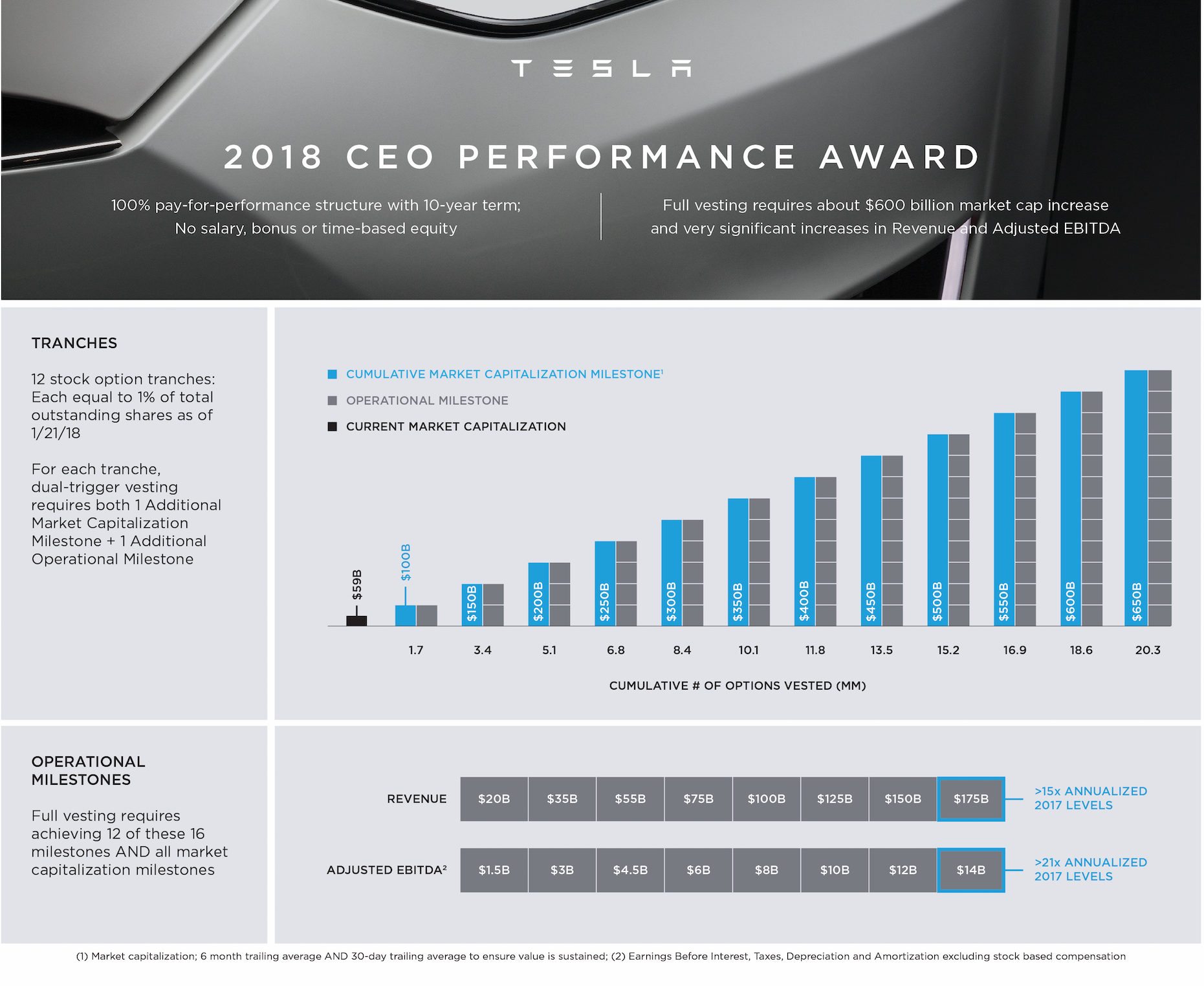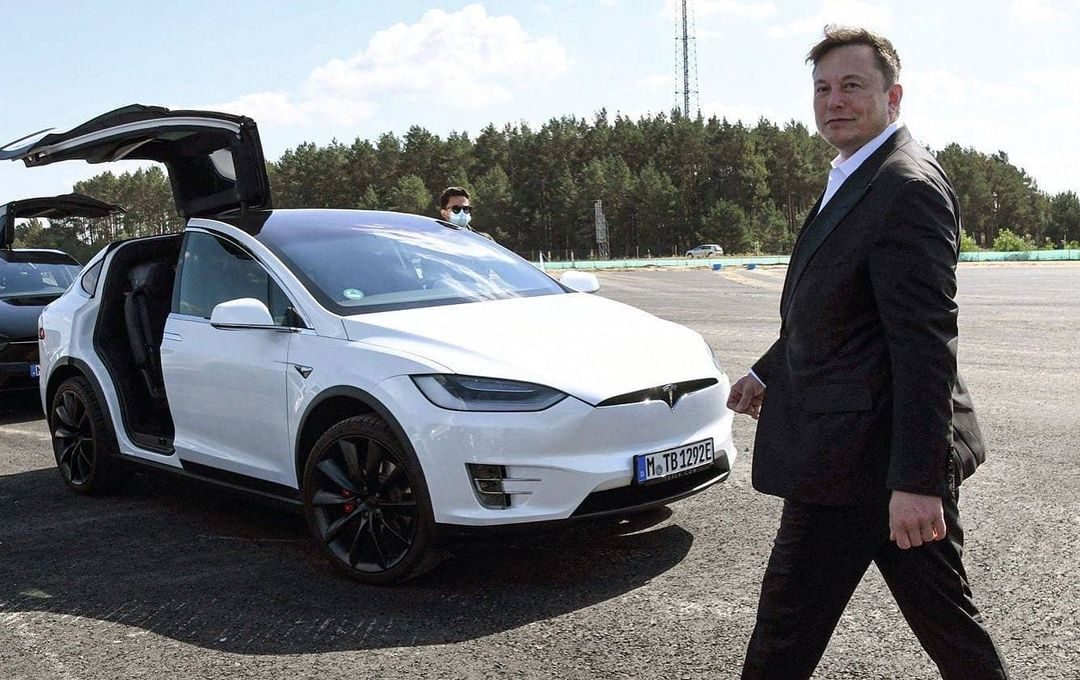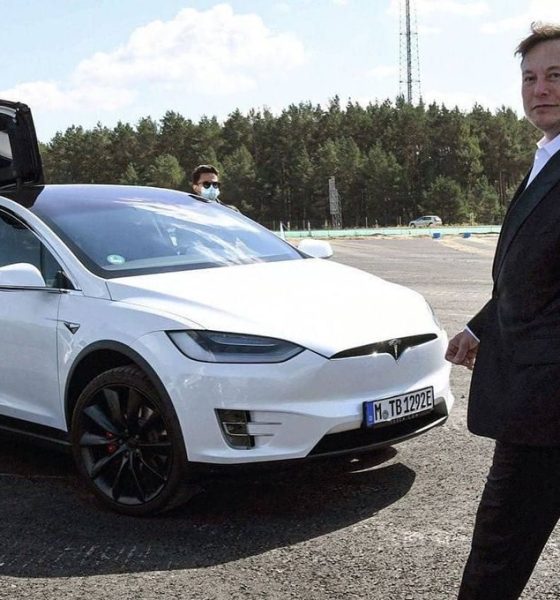Back in 2018, Elon Musk and Tesla (NASDAQ:TSLA) proposed a compensation plan that was just about as insane as the vehicles that the company produces. Dubbed as one of the most radical CEO payment plans in corporate history, it required Musk to hit a series of market cap and operational targets before he is compensated. If he succeeds, he is paid heartily, making him one of the wealthiest persons in the world by net worth. If he fails, he gets nothing.
“If all that happens over the next ten years is that Tesla’s value grows by 80 or 90%, then my amount of compensation would be zero,” Elon Musk said, describing his payment plan to The New York Times.

A dozen Market cap targets were set, each $50 billion more than the next, starting at $100 billion and so on. Revenue and adjusted profit goals were also established. For each tranche that is achieved, Elon Musk would have the option to purchase about 1% of Tesla stock at $70 per share. Considering that Tesla’s market cap only stood at $59 billion then, the ambitious compensation plan was dubbed as laughably impossible by critics.
“Mr. Musk’s critics — and there are many — are likely to contend that the new compensation plan is just the company’s latest publicity stunt. He has been called a modern-day P.T. Barnum who has created the illusion of success while consistently missing production estimates. The company continues to lose money; at one point last year, it was losing almost a half-million dollars an hour… Jim Chanos, a short-seller who has bet against Tesla’s shares — and has thus far been on the losing side of that trade — has contended that Tesla is worthless,” the NYT wrote then.
That was just over three years ago.
In a securities filing last Friday, Tesla noted that Elon Musk had achieved 6 of his 12 operating targets, and two more were probable soon. A good number of these targets reflected an adjusted version of earnings before interest, taxes, depreciation, and amortization. Two others represented revenue targets. As noted in a report from The Wall Street Journal, Tesla had also reached 11 of Elon Musk’s 12 market cap targets.

This is incredibly impressive considering that Musk’s 10-year performance award is only in its third year. The long-term plan was designed for a 10-year period, and even Musk, in a statement to the NYT, spoke of a decade-long timeframe when he described his performance award. “I actually see the potential for Tesla to become a trillion-dollar company within a 10-year period,” he said.
While his net worth will radically increase due to his Tesla performance award, Musk could not simply sell his shares and disappear. Under the terms of his payment arrangement, even once his TSLA shares vest, Musk would have to hold them for an additional five years before he is even allowed to sell them. And as per Elon Musk’s previous statements, this is something that he does not intend to do.
Musk’s 10-year Tesla performance award is arguably one of the most shareholder-friendly executive payment plans in the market. Other companies typically install outsize packages that often come at the expense of shareholders because executives are compensated even if they underperform. Tesla’s all-or-nothing plan for Elon Musk, on the other hand, greatly benefits shareholders as their holdings will increase in value as Tesla hits its market cap goals. This is great for long-term shareholders who hold the stock, as well as Tesla employees, as they receive TSLA shares when they are employed by the company.
At the end of December, Elon Musk owned about 22.4% of TSLA’s outstanding shares, up from 20.8% a year earlier. Tesla also has a market cap of $683.42 billion as of Friday’s close.
Disclaimer: I am long TSLA.
Don’t hesitate to contact us for news tips. Just send a message to tips@teslarati.com to give us a heads up.

News
Tesla (TSLA) receives “Buy” rating and $551 PT from Canaccord Genuity
He also maintained a “Buy” rating for TSLA stock over the company’s improving long-term outlook, which is driven by autonomy and robotics.

Canaccord Genuity analyst George Gianarikas raised his Tesla (NASDAQ:TSLA) price target from $482 to $551. He also maintained a “Buy” rating for TSLA stock over the company’s improving long-term outlook, which is driven by autonomy and robotics.
The analyst’s updated note
Gianarikas lowered his 4Q25 delivery estimates but pointed to several positive factors in the Tesla story. He noted that EV adoption in emerging markets is gaining pace, and progress in FSD and the Robotaxi rollout in 2026 represent major upside drivers. Further progress in the Optimus program next year could also add more momentum for the electric vehicle maker.
“Overall, yes, 4Q25 delivery expectations are being revised lower. However, the reset in the US EV market is laying the groundwork for a more durable and attractive long-term demand environment.
“At the same time, EV penetration in emerging markets is accelerating, reinforcing Tesla’s potential multi‑year growth runway beyond the US. Global progress in FSD and the anticipated rollout of a larger robotaxi fleet in 2026 are increasingly important components of the Tesla equity story and could provide sentiment tailwinds,” the analyst wrote.
Tesla’s busy 2026
The upcoming year would be a busy one for Tesla, considering the company’s plans and targets. The autonomous two-seat Cybercab has been confirmed to start production sometime in Q2 2026, as per Elon Musk during the 2025 Annual Shareholder Meeting.
Apart from this, Tesla is also expected to unveil the next-generation Roadster on April 1, 2026. Tesla is also expected to start high-volume production of the Tesla Semi in Nevada next year.
Apart from vehicle launches, Tesla has expressed its intentions to significantly ramp the rollout of FSD to several regions worldwide, such as Europe. Plans are also underway to launch more Robotaxi networks in several more key areas across the United States.
News
Waymo sues Santa Monica over order to halt overnight charging sessions
In its complaint, Waymo argued that its self-driving cars’ operations do not constitute a public nuisance, and compliance with the city’s order would cause the company irreparable harm.

Waymo has filed a lawsuit against the City of Santa Monica in Los Angeles County Superior Court, seeking to block an order that requires the company to cease overnight charging at two facilities.
In its complaint, Waymo argued that its self-driving cars’ operations do not constitute a public nuisance, and compliance with the city’s order would cause the company irreparable harm.
Nuisance claims
As noted in a report from the Los Angeles Times, Waymo’s two charging sites at Euclid Street and Broadway have operated for about a year, supporting the company’s growing fleet with round-the-clock activity. Unfortunately, this has also resulted in residents in the area reportedly being unable to sleep due to incessant beeping from self-driving taxis that are moving in and out of the charging stations around the clock.
Frustrated residents have protested against the Waymos by blocking the vehicles’ paths, placing cones, and “stacking” cars to create backups. This has also resulted in multiple calls to the police.
Last month, the city issued an order to Waymo and its charging partner, Voltera, to cease overnight operations at the charging locations, stating that the self-driving vehicles’ activities at night were a public nuisance. A December 15 meeting yielded no agreement on mitigations like software rerouting. Waymo proposed changes, but the city reportedly insisted that nothing would satisfy the irate residents.
“We are disappointed that the City has chosen an adversarial path over a collaborative one. The City’s position has been to insist that no actions taken or proposed by Waymo would satisfy the complaining neighbors and therefore must be deemed insufficient,” a Waymo spokesperson stated.
Waymo pushes back
In its legal complaint, Waymo stated that its “activities at the Broadway Facilities do not constitute a public nuisance.” The company also noted that it “faces imminent and irreparable harm to its operations, employees, and customers” from the city’s order. The suit also stated that the city was fully aware that the Voltera charging sites would be operating around the clock to support Waymo’s self-driving taxis.
The company highlighted over one million trips in Santa Monica since launch, with more than 50,000 rides starting or ending there in November alone. Waymo also criticized the city for adopting a contentious strategy against businesses.
“The City of Santa Monica’s recent actions are inconsistent with its stated goal of attracting investment. At a time when the City faces a serious fiscal crisis, officials are choosing to obstruct properly permitted investment rather than fostering a ‘ready for business’ environment,” Waymo stated.
News
Tesla FSD v14.2.2 is getting rave reviews from drivers
So far, early testers have reported buttery-smooth drives with confident performance, even at night or on twisty roads.

Tesla Full Self-Driving (Supervised) v14.2.2 is receiving positive reviews from owners, with several drivers praising the build’s lack of hesitation during lane changes and its smoother decision-making, among others.
The update, which started rolling out on Monday, also adds features like dynamic arrival pin adjustment. So far, early testers have reported buttery-smooth drives with confident performance, even at night or on twisty roads.
Owners highlight major improvements
Longtime Tesla owner and FSD user @BLKMDL3 shared a detailed 10-hour impression of FSD v14.2.2, noting that the system exhibited “zero lane change hesitation” and “extremely refined” lane choices. He praised Mad Max mode’s performance, stellar parking in locations including ticket dispensers, and impressive canyon runs even in dark conditions.
Fellow FSD user Dan Burkland reported an hour of FSD v14.2.2’s nighttime driving with “zero hesitations” and “buttery smooth” confidence reminiscent of Robotaxi rides in areas such as Austin, Texas. Veteran FSD user Whole Mars Catalog also demonstrated voice navigation via Grok, while Tesla owner Devin Olsen completed a nearly two-hour drive with FSD v14.2.2 in heavy traffic and rain with strong performance.
Closer to unsupervised
FSD has been receiving rave reviews, even from Tesla’s competitors. Xpeng CEO He Xiaopeng, for one, offered fresh praise for FSD v14.2 after visiting Silicon Valley. Following extended test drives of Tesla vehicles running the latest FSD software, He stated that the system has made major strides, reinforcing his view that Tesla’s approach to autonomy is indeed the proper path towards autonomy.
According to He, Tesla’s FSD has evolved from a smooth Level 2 advanced driver assistance system into what he described as a “near-Level 4” experience in terms of capabilities. While acknowledging that areas of improvement are still present, the Xpeng CEO stated that FSD’s current iteration significantly surpasses last year’s capabilities. He also reiterated his belief that Tesla’s strategy of using the same autonomous software and hardware architecture across private vehicles and robotaxis is the right long-term approach, as it would allow users to bypass intermediate autonomy stages and move closer to Level 4 functionality.










